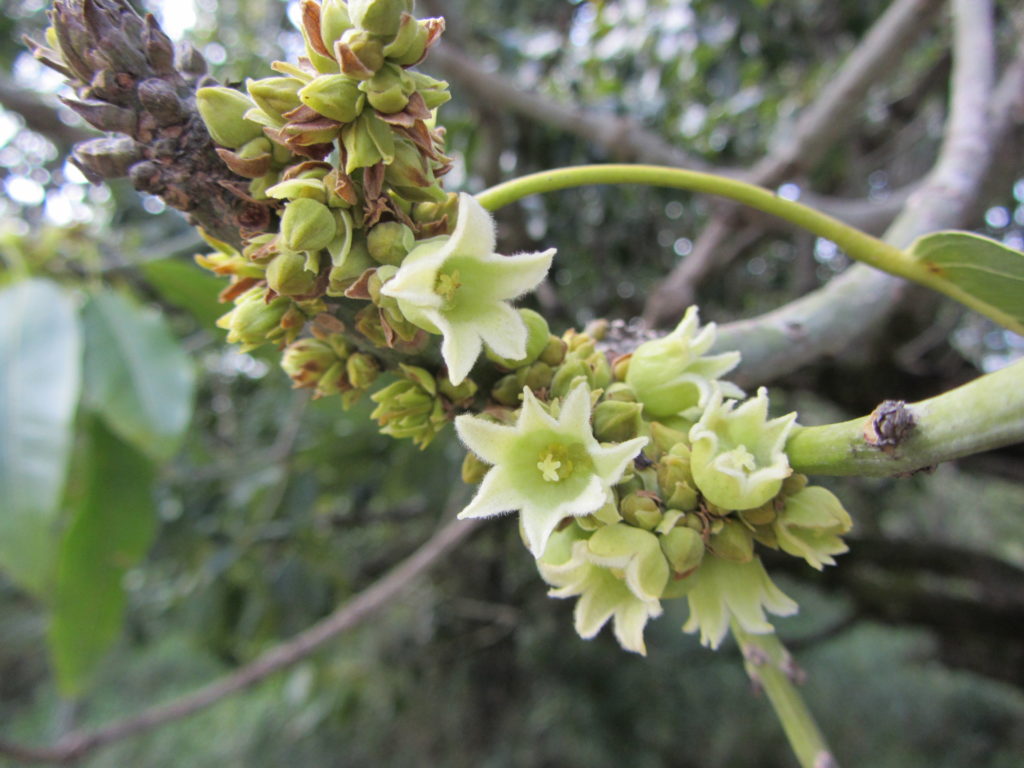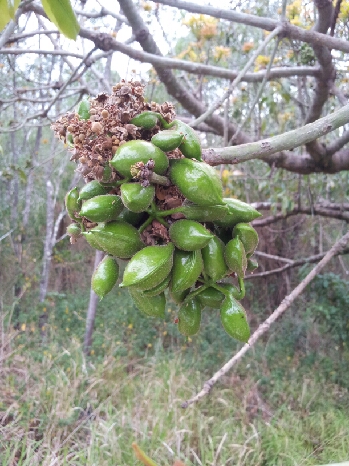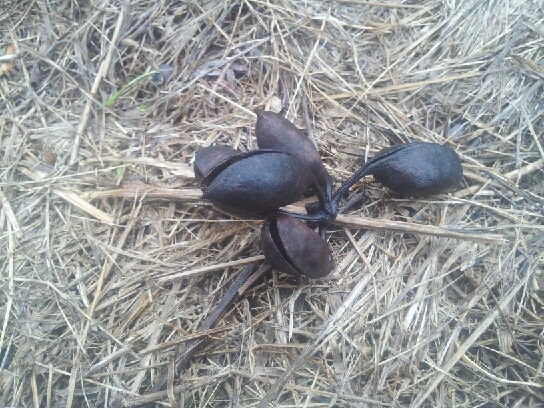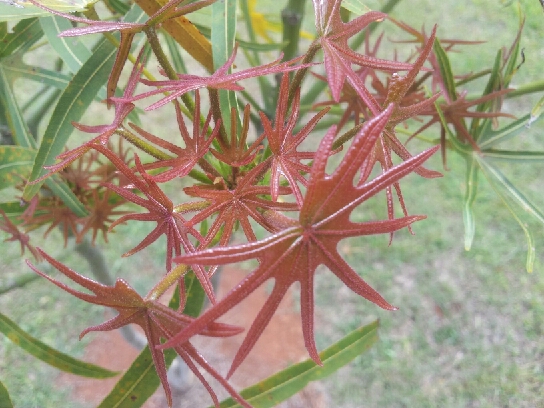I have made some interesting observations over the years regarding the Brachychiton endemic to the Ormeau area, Brachychiton sp. Ormeau (LH Bird AQ435851). It is listed as critically endangered under the federal Environment Protection and Biodiversity Conservation Act (1999) and endangered under the Queensland Nature Conservation Act (1992).

Fairly typical to many of the Brachychiton species, it will go through an array of morphological changes before it reaches mature foliage, which is simple; however, juvenile foliage is deeply lobed with long fingers. Flowers are greenish white and pods are brown and 30-60 mm long. Pods generally contain one to five bright yellow seeds, but I have observed up to 11. The seeds are covered in a hairy exotesta, the hairs are easily dislodged and cause some irritation.
Of the limited population of mature specimens of this species that remain, only a few bear any quantity of seed, and even then, since the beginnings of my observations about 18 years ago, I have seen two fruiting episodes! It is interesting to note that the seed viability is so close
to 100% and produces no noteworthy deformities, suggesting that fertile specimens are not yet at a point of genetic limitation.
Limitations on seed production and natural recruitment in seeding events are noticeable even before ripening. It can be seen that the pods are absolutely plagued by exotic rats. There is barely a pod remains on the tree that isn’t subjected to some chewing. A good proportion of what is left is attacked by a grub, which eats the seeds before moving onto the next pod.


Even after intense insect and rat attacks, 2012 was such a good year that these minor setbacks did not affect the amount of seeds that were produced. On a number of visits to the seeding trees, I had noticed that one tree in particular had been subjected to highly unethical seed collection methods and quantities. It was very disappointing. Natural limitations are often beyond human control, but regulations put in place on collection to protect already dwindling species must be upheld to allow for optimal self-recovery of these species within their environments.
After a reproductive dormancy of 12 years (prior to the recent seeding event), a huge crop of seeds was produced just before the torrential rains that south east Queensland experienced in the summer of 2013. Based on many other seed germination preferences, I considered large quantities of rain just prior to, and into seed maturity, to be favourable. On closer investigation and trials, I found this to be quite the opposite. Of the seeds that I collected and propagated through December and January 2012/2013, I found that large amounts of rain prior to germination resulted in very poor germination percentages. Even with precautionary fungicide applications to all of my seedling trays, germination was less than 10%, compared with more than 90% in the exact same conditions minus the rain. All of my trials were conducted outdoors in the full weather (in a rat proof situation).
This implies habitat and climatic limitations and intolerances for the species. A bumper year of seed production was followed by what would appear to be extremely unfavourable recruitment conditions. Records for the area indicate that 2001 (the last time the trees produced a large quantity of seeds) was a wet season also.
Interestingly, the seeding specimens all occur on Regional Ecosystem 12.3.1 (gallery rainforest on alluvial plains) classified as endangered under the Vegetation Management Act (2009). It is estimated that less than 10% of this ecosystem’s pre-clearing extent remains. Taking that into account for an already limited habitat area, these areas are frequently subjected to temporary inundation, thus subjecting seeds and seedlings to what has been observed to be unfavourable growing conditions. Regardless of the fact that this ecosystem is highly susceptible to weed invasion and was cleared extensively for agriculture, it would appear that the conditions of recent times have resulted in severe limitations on the species reproductive success. Areas subjected to grazing would see seedlings trampled and young plants eaten. Brachychitons are frequently eaten by cattle with the Queensland Bottle Tree (Brachychiton rupestris) used as fodder during droughts.
Brachychiton sp. Ormeau is a handsome, hardy tree with a limited population. Juvenile foliage is interesting and unique, and the new growth is beautiful and bright maroon-red. Flowers are not spectacular by Brachychiton standards, but are beautiful in their own right. It is a tree that can be easily propagated and is certainly worthy of cultivation. I am proudly donating my seedlings to the conservation of the species.

Article and photos by David Madden, Land for Wildlife member, Guanaba, Gold Coast

good story….are these available in SA?
It is quite a rare tree, so is only available occasionally in select native plant nurseries such as Burringba Nursery http://burringbarrainforestnursery.com.au/
I just got one at Northern Rivers Natives, just down the road…
Hi David,
I just bought two Ormeau bottle trees from Burringbar Native Plant Nursery (May 2019).
Thanks for pointing me in the right direction.
Cheers,
Blake
We recently visited our park Darlington nature reserve at Ormeau as it has been discovered that there is a small patch in our park
Thats great to hear Bruce. Thanks for commenting.
Hi could you please let me know where this park is situated
Dear Bruce Watson,
A friend and I would like to see the small patch you mentioned in your post, but I could not pin down the location of the reserve. I live on Tamborine Mountain and my friend lives outside Canungra. I would greatly appreciate your help in directing us to any mature Brachychiton sp ormeau that are readily accessible to the public. Thank you,
Peter Kuttner
Hi Peter. You may wish to contact the author of the original article, Dave Madden at his nursery, Nightjar Natives – nightjarnatives@hotmail.com. He might be able to assist you. As a general rule, we don’t provide specifics on the location of any threatened species due, unfortunately, to illegal harvesting and trade.
We have a single tree that has had pods this year but they seem to be empty. We acquired the tree a seedling about 15 years ago from a bush care group. Do we need a second tree for fertile seed? We live in the Lamington area.
Planted one in my garden in Manly West about a year ago, it must like where it is as it has doubled in size in that year. I’ll get a picture of it to show you how it’s going. The base is about 3inches in diameter.
Where did you get yours from?
We are wanting to plant one on the Reserve in Gerringong
Kind Regards
Jen Gatdner
Where can you sorce seed from the immature leaves intrigue me !!!!!
Hi Peter. Burringbar Native Plant Nursery usually stocks the Ormeau Bottle Tree. http://burringbarrainforestnursery.com.au/
do you need to plants two fruit the seed?
St Hilda’s School Southport planted an Ormeau bottle tree a few years ago and it is doing very well.
Hi,
I’ll be producing grafted specimens again this year. My planted specimens are at flowering age now. Please refrain from collecting from the wild. There may be some seedlings also, but as mentioned it is generally reluctant to set seed. Feel free to email me at nightjarnatives@hotmail.com to preorder or get in contact with retailers of where my stock went last year.
Thanks for the interest, Dave Madden.
Hi there, We have 2 or 3 babies of these growing on our property- (we have 1 fully established tree ) I’ve just found out what they are and they aren’t in ideal locations, can they be transplanted? If so how can I look after them?
Regards
Ash
Hi, Have just seen this tree on gardening Australia (Griffith Uni), am looking for an evergreen shade tree with non invasive roots, that I can prune to a 3 metre canopy (for shade). Is this tree evergreen and does it satisfy my requirements?
Alternatives I considering are poinsettia (but dislike the decidious nature) or tuckeroo (ideal but not too exciting a specimen).Tree destined for Caloundra garden. Any better alternatives?
Thanks.
Hi Jeffrey. There are plenty of excellent native plant nurseries on the Sunshine Coast that would be more than happy to discuss this with you. Some nursery options are listed on the Australian Native Plant Society website http://anpsa.org.au/nursery.html#queen
Goodluck.
Its fantastic to see people so keenly interested in our natural heritage. Australias native plants, animals and ecologies can’t be preserved if nobody is passionate about them. So much is lost and threatened now from development and exotic invasive plants but that tide can be reversed. I hope the future holds much much more of this. Valuable article you’ve composed here David, well done!
Jan Drynan most kindly gave me some seed and after two weeks the first one germinated this morning with the cotyledons sticking out. Yea I have finally got a big O.!!!
‘Question is any one working on having the species recognised taxnomically thanks Jan for seed Peter
I live in Ormeau and I think I have one of these tree growing on the boundary of my property. Can I send you some pictures for identification? I will keep an eye on it and advise if is fruits.
Yes of course. We have sent you an email.
I just purchased one from the Logan River tree farm Beenleigh
Planted two at my property, purchased from Logan branch of SGAP. Doing well on mudstone enriched by basalt.
I think we have a seedling, my partner cut down the tree that was too close to our house was about 4 metres high and a few months later found a seedling which is about 50 cm high now which I potted up. We are situated in Tasmania.